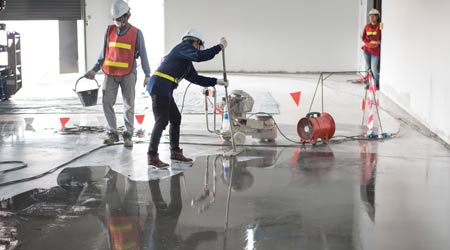 As concrete coatings evolve, managers need to understand which products will work best for their substrates.
As concrete coatings evolve, managers need to understand which products will work best for their substrates.Looking for Concrete Trouble Spots
Expanding product options and growing pressure to protect concrete surfaces can mean complex decisions for managers
Regardless of the location in which a concrete coating is applied, managers need to remember one given: Concrete wears down, cracks and breaks. Some of the most common concrete issues that technicians should look for are moisture transfer and problems with load-bearing capacity.
“Today, more water and cheaper fillers are used in concrete more than ever,” Elliot says. “This inevitably leads to more issues. One of the biggest we face is moisture transfer. Always remember to test for moisture-vapor transmission prior to choosing a coating system. The good news is there are many topside vapor barriers available on the market today. Typically most concrete coatings can hold back 3 pounds of moisture vapor transmission per square inch.
“When looking for moisture transfer, managers can look for little white salt deposits because sometimes the moisture will push salt through the concrete. Sometimes, you can just see the dampness and moisture.”
In order to ensure that concrete coatings perform as intended, managers need to make sure they specify products that are formulated for the intended application.
“Not all products are meant for all environments,” Tierney says. “The use of the area should be discussed with the flooring contractor to determine the best system and chemistry required for the area. The type of traffic — foot, carts, forklifts, etc. — loads, chemicals, conditions, thermal shock, and other abuses should be reviewed to ensure the proper flooring is used.”
Managers can consult with a flooring contractor or manufacturer to get product information that will help them specify an effective coating.
“Most coating manufacturers have chemical-resistance data that they can provide to a specifier,” Thome says. “This information can be evaluated, but not every substrate is the same and not every facility is the same. The only way to determine if a protective coating system is right for you is to have an in-place mockup installed. This mockup can then be tested to determine if it will provide the level of protection required in your facility.”
One of the most effective steps managers can take to prevent moisture transfer is to ensure proper application for the concrete coating specified. But the application process can present its own set of challenges.
“There is one common factor that every floor has in common with another: No two are the same,” Thome says. “Concrete is one of the only building materials that is manufactured on site. It goes from a plastic to a hardened state on the job site. That is one of the many reasons it is so widely used. But it also needs to properly cure to develop its intended strength.
“The proper level of cure is critical in producing a surface with a long service life, coated or uncoated. A big trouble spot for the manager is the durability of their existing wear surface. Can it handle the use it is now going to be used for? Protective coatings cannot increase the load-bearing capacity of an existing concrete slab. They can only protect it from attack it might see during everyday use and prolong its service life.”
Related Topics:














